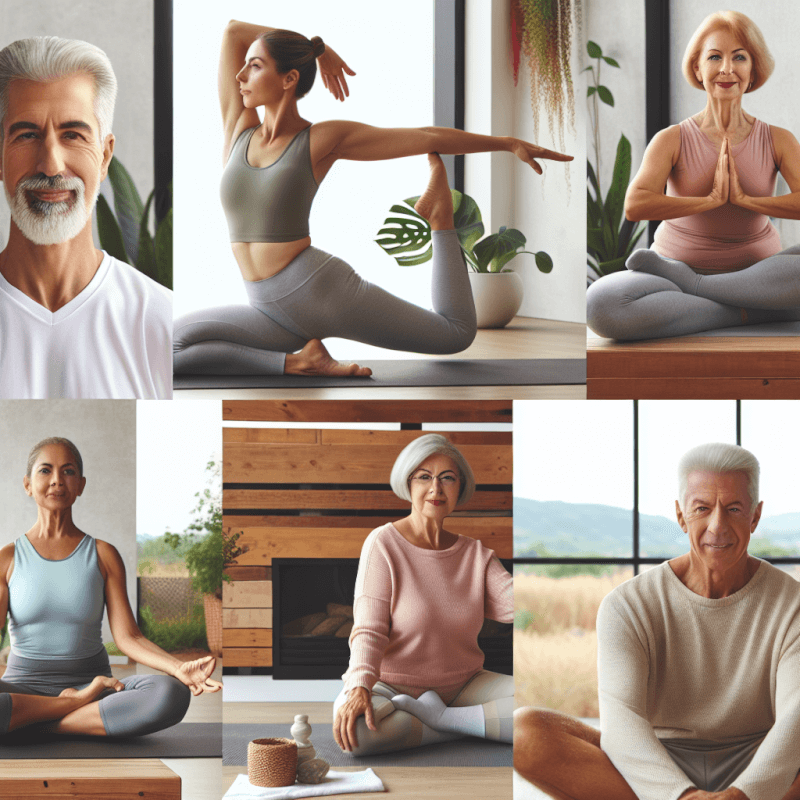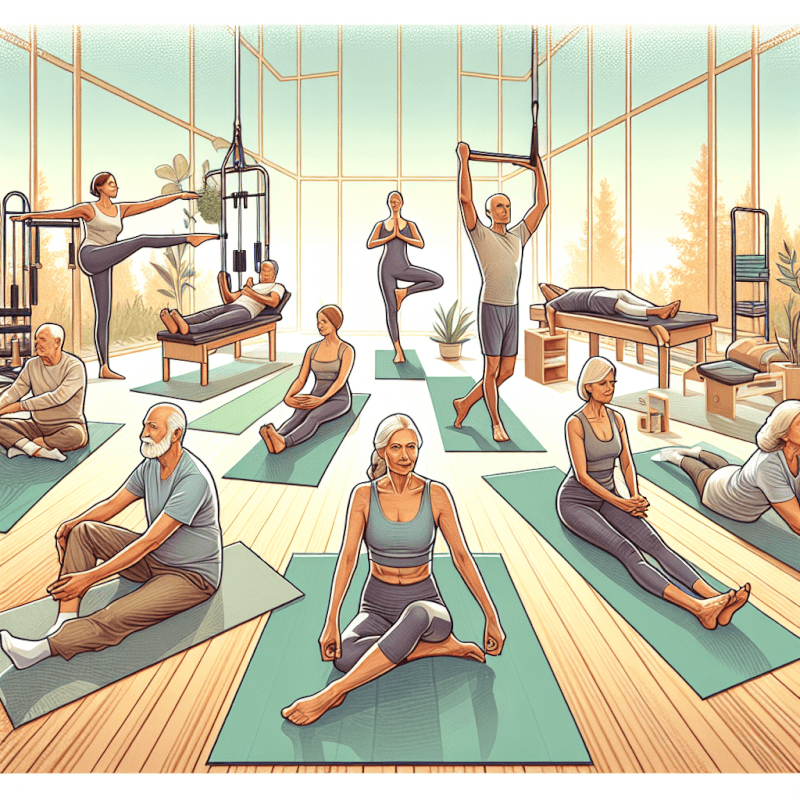If you’re in your 50s or 60s and looking to improve your overall well-being, you may be wondering if yoga or Pilates are suitable exercise options for you. Both yoga and Pilates offer a gentle yet effective way to stay active, build strength, and increase flexibility, making them potentially beneficial exercises for individuals in their 50s or 60s. In this article, we’ll explore the numerous benefits of practicing yoga or Pilates as you enter this stage of life and discuss how these exercises can help you feel stronger, more balanced, and more connected to your body. So, let’s dive in and discover the positive impacts that yoga or Pilates may have on your health and vitality in your 50s or 60s.

Benefits of Yoga and Pilates for people in their 50s or 60s
As you enter your 50s or 60s, prioritizing your physical and mental well-being becomes increasingly important. Both yoga and Pilates offer numerous benefits for individuals in this age group, helping to maintain and improve flexibility, strength, balance, stability, joint health, and mental well-being. Incorporating these practices into your routine has the potential to enhance your overall quality of life, promoting a healthy and active lifestyle as you age gracefully.
Improved flexibility
One of the standout benefits of both yoga and Pilates is the improvement in flexibility that they offer. Both practices incorporate stretching and lengthening exercises that target various muscle groups, increasing your range of motion and promoting healthy joint function. Improved flexibility allows you to move freely and comfortably, reducing the risk of injuries and enhancing everyday activities such as bending, reaching, and twisting.
Increased strength
Yoga and Pilates are not only excellent for flexibility but also for increasing strength. Both practices utilize bodyweight exercises and resistance-based movements to target different muscle groups. Yoga focuses on holding poses that require strength, such as plank and warrior poses, while Pilates incorporates movements that engage your core, targeting deep abdominal muscles that are essential for stability and overall strength. Building strength through yoga and Pilates can improve your ability to perform daily tasks, maintain good posture, and support joint health.
Enhanced balance and stability
Maintaining balance and stability is crucial as we age, preventing falls and supporting overall mobility. Yoga and Pilates offer specific poses and exercises that challenge your balance, helping to improve proprioception and strengthen the muscles responsible for stability. Whether you are practicing balancing poses in yoga or performing exercises on unstable surfaces during Pilates, both practices are effective in enhancing balance and stability, reducing the risk of accidents.
Reduced joint pain
As we age, joint pain and stiffness can become common issues. Yoga and Pilates can help alleviate these symptoms by improving joint health and flexibility. The gentle, low-impact nature of both practices makes them ideal for individuals in their 50s or 60s who may have pre-existing joint conditions such as arthritis. Both yoga and Pilates emphasize proper alignment and mindful movement, reducing the strain on your joints and promoting a pain-free range of motion.
Enhanced mental well-being
Physical exercise is not only beneficial for the body but also for the mind. Yoga and Pilates emphasize mindfulness and breath awareness, promoting relaxation and reducing stress levels. Engaging in these practices can help combat the effects of a hectic lifestyle, allowing you to find moments of calm and mental clarity. Incorporating yoga and Pilates into your routine provides an opportunity for self-care and introspection, improving your overall mental well-being and helping you cultivate a positive outlook.
Yoga for people in their 50s or 60s
Gentle yoga poses
Gentle yoga poses are suitable for individuals in their 50s or 60s who are new to yoga or have physical limitations. These poses focus on slow stretching and gentle movement, promoting flexibility and relaxation. Some examples of gentle yoga poses include seated forward bends, supported standing poses, and gentle twists. Practicing these poses regularly can help improve flexibility, reduce muscle tension, and promote a sense of calm.
Yoga for flexibility
Yoga is renowned for its ability to enhance flexibility, making it an ideal practice for individuals in their 50s or 60s. Specific yoga poses such as downward dog, warrior poses, and triangle pose target different muscle groups and promote lengthening and stretching. Regular practice can gradually improve flexibility and range of motion, allowing you to move with ease in your daily activities.
Yoga for strength
While yoga is often associated with flexibility, it also offers numerous strength-building benefits. Poses such as plank, boat pose, and chair pose engage your muscles and build strength in your arms, legs, and core. By incorporating strength-focused poses into your yoga practice, you can improve muscle tone, increase overall body strength, and support joint stability.
Yoga for balance and stability
Many yoga poses inherently require balance, making it an excellent practice for improving stability. Poses like tree pose, eagle pose, and extended hand-to-big-toe pose challenge your balance and activate the muscles responsible for stability. Regular practice of these poses can improve balance and coordination, reducing the risk of falls and promoting confidence in your everyday movements.
Yoga for joint pain
Individuals in their 50s or 60s may experience joint pain or stiffness. Yoga offers modifications and poses specifically designed to reduce joint discomfort. Gentle movements, such as cat-cow pose, gentle seated twists, and supine leg stretches, can help alleviate pain and improve joint mobility. It is essential to listen to your body and avoid any poses or movements that cause discomfort. Always consult with a healthcare professional if you have any concerns or underlying joint conditions.
Yoga for mental well-being
In addition to the physical benefits, yoga provides numerous mental health benefits for individuals in their 50s or 60s. The combination of gentle movement, deep breathing, and mindfulness cultivates a sense of calm and relaxation. Regular yoga practice can help reduce stress, improve sleep quality, and enhance overall mental well-being. A variety of yoga styles, such as restorative yoga or yin yoga, focus on relaxation and provide a soothing practice that can be especially beneficial for individuals seeking stress relief.
Pilates for people in their 50s or 60s
Low-impact exercises
Pilates is well-suited for individuals in their 50s or 60s due to its low-impact nature. The controlled, deliberate movements of Pilates help build strength, improve flexibility, and enhance overall body awareness without placing excessive strain on the joints. By focusing on engaging the core muscles and controlled breathing, Pilates offers a safe and effective workout option for individuals looking to maintain or improve their fitness levels.
Pilates for flexibility
Similar to yoga, Pilates includes exercises that improve overall flexibility. The movements in Pilates, such as the spine stretch, hamstring stretch, and hip opener exercises, target specific muscle groups, enhancing their length and flexibility. Regular Pilates practice can help increase flexibility, making everyday movements more comfortable and reducing the risk of injuries.
Pilates for strength
Pilates is renowned for its ability to target and strengthen the core muscles, including the deep abdominals, back, and pelvic floor muscles. The controlled and precise movements in Pilates engage these muscles, promoting a strong and stable core, which is essential for maintaining good posture and supporting the spine. In addition to the core, Pilates exercises also work the muscles of the arms, legs, and glutes, providing a full-body strengthening workout.
Pilates for balance and stability
Like yoga, Pilates emphasizes balance and stability through specific exercises that challenge your body’s ability to maintain control. Movements such as standing balance exercises, single-leg exercises, and exercises performed on unstable surfaces help improve proprioception and strengthen the muscles responsible for balance. Incorporating Pilates into your routine can enhance your overall stability, reducing the risk of falls and improving your confidence in daily activities.
Pilates for joint pain
Individuals in their 50s or 60s who experience joint pain or stiffness can benefit from Pilates exercises that promote joint health and mobility. The controlled movements and emphasis on alignment in Pilates help improve joint stability and reduce the strain on the joints. Exercises such as leg circles, bridging, and gentle spinal movements can help alleviate joint discomfort and promote healthy joint function.
Pilates for mental well-being
In addition to its physical benefits, Pilates can have a positive impact on your mental well-being. The focus on precise and controlled movements promotes mindfulness and body awareness, encouraging you to be fully present in the practice. Pilates sessions provide an opportunity to disconnect from the demands of daily life and focus on your breath and movement, promoting relaxation and reducing stress levels.
Considerations for practicing yoga or Pilates in your 50s or 60s
When starting or continuing a yoga or Pilates practice in your 50s or 60s, it is essential to consider a few key considerations to ensure a safe and beneficial experience.
Consulting with a healthcare professional
Before starting any new exercise program, it is advisable to consult with a healthcare professional, especially if you have any pre-existing health conditions or concerns. They can provide valuable insights and guidance tailored to your specific needs, ensuring that yoga or Pilates is appropriate for you.
Starting slowly and gradually
It is important to start your yoga or Pilates practice at a pace that suits your fitness level and abilities. Begin with gentle beginner-level classes or sessions and gradually build up your strength and flexibility. Listen to your body and avoid pushing yourself too hard or attempting advanced poses or exercises before you are ready.
Modifying poses or exercises
Yoga and Pilates offer modifications for every pose or exercise, allowing you to tailor the practice to your individual needs. If a particular pose or exercise feels challenging or causes discomfort, don’t hesitate to use props, alter the movement, or seek guidance from a qualified instructor. Modifying poses or exercises ensures that you can participate safely and comfortably.
Listening to your body
As you practice yoga or Pilates, it is important to listen to your body’s cues. If a pose or exercise feels painful or overly strenuous, modify or skip it altogether. Pay attention to any sensations or discomfort, and adjust your practice accordingly. Your body will guide you to what feels right for you.
Choosing appropriate classes or instructors
When selecting yoga or Pilates classes, opt for those specifically designed for individuals in their 50s or 60s, or look for gentle or senior-focused classes. Instructors experienced in working with older adults can provide guidance, modifications, and appropriate exercises to ensure a safe and enjoyable practice.

Precautions and modifications for people in their 50s or 60s
While yoga and Pilates are suitable for individuals in their 50s or 60s, it is essential to take certain precautions and make modifications to ensure a safe and beneficial practice.
Avoiding high-impact movements
Steer clear of high-impact movements or exercises that place excessive strain on your joints. Jumping or sudden jarring motions should be avoided to prevent injuries. Focus on low-impact exercises that promote body awareness, gradual progress, and controlled movements.
Using props for support
Props such as yoga blocks, straps, and blankets can provide additional support and stability during yoga or Pilates sessions. Incorporating props can help you achieve correct alignment, maintain balance, modify poses, and prevent strain or injury. Don’t hesitate to utilize props when needed to enhance your practice.
Avoiding overstretching or overexertion
While it is important to improve flexibility and strength, it is equally crucial to avoid overstretching or overexerting yourself, especially if you are new to yoga or Pilates. Always work within your comfortable range of motion and only push yourself gently without causing pain or discomfort. Gradual progress is key to avoiding injuries and allowing your body to adapt to the practice.
Being mindful of existing health conditions
If you have any existing health conditions or concerns, such as heart disease, osteoporosis, or chronic pain, it is important to be mindful of the potential impact of yoga or Pilates on your condition. Inform your instructor about your health history, and consult with your healthcare professional for specific guidelines and recommendations.
Adapting to individual abilities
Remember that everyone’s body is unique, and it is essential to adapt the practice to your individual abilities. Avoid comparing yourself to others and focus on what feels right for you. Honor your limits, practice self-compassion, and celebrate your progress, no matter how small.
Finding the right yoga or Pilates class for people in their 50s or 60s
When searching for a yoga or Pilates class as someone in their 50s or 60s, it is crucial to find a class that suits your specific needs and goals. Consider the following factors when choosing a class:
Senior or gentle yoga classes
Look for classes specifically designed for seniors or labeled as gentle yoga classes. These classes are tailored to accommodate the unique needs of older adults and often focus on modified postures and gentle movements suitable for individuals in their 50s or 60s.
Yoga classes for beginners
If you are new to yoga, consider attending beginner-level classes. These classes provide a solid foundation, introducing you to basic poses, alignment principles, and the overall flow of a yoga practice. Starting at a beginner level allows you to learn proper form and gradually build strength and flexibility.
Specialized Pilates classes
Some Pilates studios or fitness centers offer specialized classes that cater specifically to older adults. These classes often incorporate modifications, adaptations, and exercises that focus on the specific needs of individuals in their 50s or 60s. Look for classes labeled as “senior Pilates” or “Pilates for older adults.”
Classes with experienced instructors
Seek out classes taught by instructors experienced in working with older adults. These instructors will have a deeper understanding of the physical limitations and considerations specific to this age group. Their expertise can ensure you receive the guidance and modifications necessary to practice safely and effectively.
Incorporating modifications and progressions
Choose classes that incorporate modifications and progressions to accommodate various fitness levels and abilities. Look for instructors who encourage individualized modifications and provide options for both beginners and more advanced practitioners. Being able to adapt the practice to your specific needs ensures a personalized and beneficial experience.

Benefits of practicing yoga and Pilates together
While both yoga and Pilates offer numerous benefits on their own, practicing them together can provide complementary benefits and enhance your overall well-being.
Complementary benefits
Yoga and Pilates target different aspects of physical fitness and mental well-being. Yoga focuses on flexibility, balance, and mindfulness, while Pilates emphasizes core strength, overall body strength, and body awareness. By incorporating both practices into your routine, you can enjoy a comprehensive workout that addresses various aspects of your fitness and overall well-being.
Enhanced muscle tone
Practicing yoga and Pilates together helps increase muscle tone throughout the entire body. Yoga poses engage and strengthen specific muscle groups, while Pilates exercises target the deep core muscles responsible for stability and proper alignment. The combination of both practices promotes overall muscle definition and a toned physique.
Improved mindfulness and body awareness
Yoga and Pilates both emphasize mindfulness and body awareness. Yoga incorporates breathwork and meditation, while Pilates focuses on precise and controlled movements. Practicing both disciplines together cultivates a deeper mind-body connection, enhancing concentration and self-awareness. The increased mindfulness carries over into your daily life, allowing you to navigate tasks with greater focus and presence.
Increased energy levels
Both yoga and Pilates are energizing practices. Yoga stimulates the body through controlled movements and deep breathing, promoting blood flow and energy circulation. Pilates focuses on activating the muscles responsible for posture and overall body support, which increases your overall energy and vitality. Combining these practices provides a holistic approach to boost your energy levels and combat fatigue.
Holistic approach to well-being
The combination of yoga and Pilates offers a comprehensive approach to overall well-being. Yoga encourages mental and emotional balance, stress reduction, and relaxation, while Pilates strengthens and tones the body. The dual practice not only improves physical fitness but also supports mental clarity, allowing you to achieve a sense of balance and harmony in your life.
Testimonials and success stories
Numerous individuals in their 50s or 60s have shared their personal testimonials and success stories about how yoga and Pilates have positively impacted their lives.
Personal experiences of individuals in their 50s or 60s
Many individuals in their 50s or 60s have found that practicing yoga and Pilates has improved their overall well-being. They report increased flexibility, improved strength, reduced joint pain, enhanced balance, and greater mental clarity. Through regular practice, they have overcome physical limitations, achieved personal milestones, and experienced a renewed sense of vitality.
Positive impacts on overall health
Yoga and Pilates have been shown to have positive impacts on overall health, regardless of age. By incorporating these practices into their routine, individuals in their 50s or 60s have reported lower stress levels, improved sleep quality, and increased body awareness. They have also noticed improvements in their cardiovascular health, digestion, and immune function.
Improvement in specific health conditions
Practicing yoga and Pilates has also been reported to improve specific health conditions that commonly affect individuals in their 50s or 60s. People with arthritis have found relief from joint pain and increased joint mobility. Those managing osteoporosis have experienced enhanced bone density and strength. Individuals with chronic pain conditions have found yoga and Pilates to be effective complementary therapies in managing their symptoms.
Enhanced quality of life
Overall, individuals in their 50s or 60s have credited yoga and Pilates with enhancing their quality of life. The physical and mental benefits of these practices have allowed them to maintain an active lifestyle, engage in activities they enjoy, and age gracefully. Through yoga and Pilates, they have discovered a sense of joy, fulfillment, and self-empowerment.

Conclusion
As you enter your 50s or 60s, incorporating yoga and Pilates into your routine can have a profound impact on your physical and mental well-being. The benefits of improved flexibility, increased strength, enhanced balance, reduced joint pain, and enhanced mental well-being make these practices a valuable addition to your lifestyle. Whether you choose yoga, Pilates, or a combination of both, tailoring your practice to your individual needs and abilities will allow you to experience the joy and fulfillment that come with taking care of yourself at any age. Embrace the opportunity to move, breathe, and find inner peace as you age gracefully and cultivate a healthy, active, and fulfilling life.


